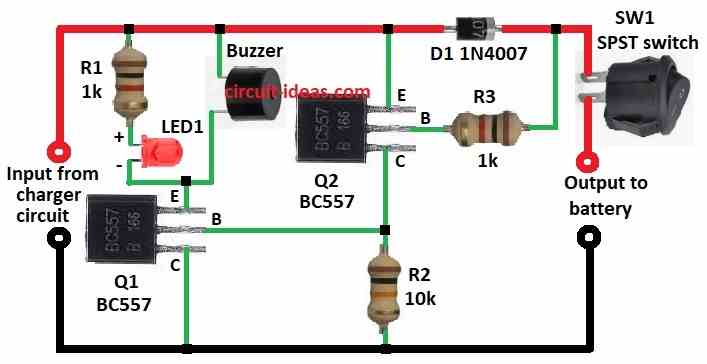In electronic systems, it is really important to have a reliable charger circuit to keep power flowing to important devices like rechargeable batteries.
The Simple Charger Breakdown Alarm Circuit is made to keep an eye on the charger circuit and sound an alarm with a buzzer if something goes wrong.
This way, users will know right away if the charger stops working, which helps prevent the battery from getting drained or damaged.
This circuit is built with simple parts like transistors, resistors a diode, an LED and a buzzer making it affordable and easy to put together.
The alarm acts as a safety feature, giving users quick alerts if there is a problem with the charging process.
Circuit Working:

Parts List:
| Component | Value/Specification |
|---|---|
| Resistors | |
| 1k | 2 |
| 10k | 1 |
| Semiconductors | |
| Transistors BC557 | 2 |
| Diode 1N4007 | 1 |
| LED 5mm, 20mA | 1 |
| Buzzer | 1 |
| SPST Switch | 1 |
The Simple Charger Breakdown Alarm Circuit works using a basic transistor switching method.
The charger connects with the supply rails of the circuit for the needed input voltage.
When the charger is on, it sends positive voltage to the circuit allowing it to work properly.
Resistor R1 1k and LED1 are linked together.
When the charger is active, the LED lights up showing that there is input voltage from the charger.
The circuit has two PNP transistors Q1 and Q2 BC557 that keep track of the charging status.
Normally, when the charger is providing power, the base of Q1 is kept low, which keeps it ON and stops the buzzer from sounding.
The base of Q2 also stays low keeping the circuit steady.
If the charger stops working or fails, the base voltage of Q1 and Q2 increases (thanks to the pull down resistor R2 and the missing input supply).
This change turns off Q1 and Q2 which makes the buzzer go off, giving a sound alert.
Diode D1 1N4007 protects the circuit from any reverse voltage making sure it runs smoothly.
Switch SW1 lets the user turn the buzzer on or off manually.
If the alarm is not needed, SW1 can be turned OFF.
The output supply of the circuit connects with the battery.
This circuit makes sure that if there is a problem with the charger, the alarm goes off before the battery gets affected.
Formulas with Calculations:
The LED Current Limiting Resistor (R1): is used to make sure that the current flowing through the LED stays at a safe level.
The value of the resistor is figured out to prevent too much current from passing through the LED.
R1 = (V_in – V_LED) / I_LED
where,
- V_in is the input voltage for 12V
- V_LED is the forward voltage drop of the LED for 2V
- I_LED is the desired LED current for 20mA = 0.02A
Calculation:
R1 = (12V – 2V) / 0.02A R1 = 10V / 0.02A R1 = 500Ω
A 1kΩ resistor is used in real life to help control the flow of electricity and keep things safe.
Transistor Base Resistor (R3): The resistor that is linked to the base of the transistor is made to make sure it switches correctly.
R3 = (V_in – V_BE) / I_B
where,
- V_in is the input voltage to the base resistor for 12V
- V_BE is the base emitter voltage drop from 0.7V for BC557
- I_B is the base current
Base current (I_B) is determined as: I_B = I_C / h_FE
where,
- I_C is the collector current from 50mA for the buzzer)
- h_FE is the current gain of the transistor which is 100
Calculation:
I_B = 50mA / 100 I_B = 0.5mA
R3 = (12V – 0.7V) / 0.0005A R3 = 11.3V / 0.0005A R3 = 22.6kΩ
A resistor between 1kΩ and 10kΩ is usually used in real life situations to make sure the switching works correctly.
How to Build:
To build a Simple Charger Breakdown Alarm Circuit follow the below mentioned steps:
- Gather all the components as mentioned in the above circuit diagram.
- Connect the collector of transistor Q1 to GND.
- Connect the base of transistor Q1 to collector of transistor Q2.
- Connect the emitter of transistor Q1 to one terminal of buzzer and other end of buzzer to positive supply.
- Connect a LED1 and resistor R1 from of the emitter of transistor Q1 and the other end of LED1 and resistor R1 to positive supply.
- Connect collector of transistor Q2 to GND through resistor R2.
- Connect the base of transistor Q2 to positive supply between diode D1 and SW1 switch through resistor R3.
- Connect the emitter of transistor Q2 to positive supply
Conclusion:
The Simple Charger Breakdown Alarm Circuit is an easy and useful way to keep an eye on how a charger is working.
It uses basic electronic parts to give both a light LED and a sound buzzer warning if something goes wrong.
This helps people act quickly to prevent their batteries from running out or getting damaged.
Because it is inexpensive and simple to build, this circuit is great for both hobbyists and professionals who want a dependable way to monitor their chargers.
By putting together this circuit, users can make sure their battery systems stay safe and that any problems with charging are quickly fixed.
Leave a Reply